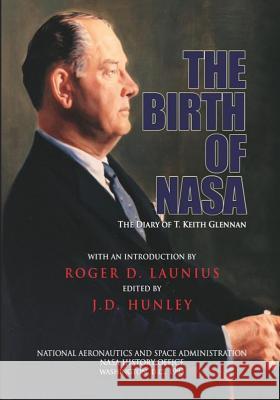The Birth of NASA: The Diary of T. Keith Glennan » książka
The Birth of NASA: The Diary of T. Keith Glennan
ISBN-13: 9781495444364 / Angielski / Miękka / 2014 / 430 str.
The Birth of NASA: The Diary of T. Keith Glennan
ISBN-13: 9781495444364 / Angielski / Miękka / 2014 / 430 str.
(netto: 98,61 VAT: 5%)
Najniższa cena z 30 dni: 102,69 zł
ok. 16-18 dni roboczych
Bez gwarancji dostawy przed świętami
Darmowa dostawa!
"The Birth of NASA-The Diary of T. Keith Glennan" tells the story of the critical formative months of the new agency. The Introduction describes the background of T. Keith Glennan, the first NASA Administrator. After the Introduction, the book continues with Glennan's recollections of NASA from his appointment until the end of 1959. The 13 chapters are written in a diary format covering month-by-months his activities until he left the position in 1961. A Postscript, written in 1963, gives his views on the space program after he left office. A Biographical Appendix gives short sketches of about 400 individuals active in the space program during this period. Throughout the diary numerous explanatory footnotes by the editor clarify events an provide references for further details. Although Glennan's stay at NASA was short, his contributions are most significant, as he built the organization that would men to the moon and serve the nation to the present time. By T. Keith Glennan: "When I first began keeping this journal or diary, I never thought that it might, one day, be published. When I was appointed as the first Administrator of the newly authorized National Aeronautics and Space Administration on 19 August 1958, I started to keep a hand-written diary of sorts but soon found that my time was all too limited for that task. When I went back to Cleveland for the year-end holidays in 1959, I found that my four children had become much interested in knowing more about my job. They were also developing an interest in national and international affairs that intrigued me. I resolved to record my activities using my daily appointment cards to remind me of the important meetings that had become a daily way of life. I had a small, battery-operated recording machine called a dictette, and I usually dictated a summary of the day's happenings before I turned off the light each night. I sent the tapes back to my office at Case Institute of Technology in Cleveland where my secretary, Barbara Helberg, transcribed and stored them. I never saw them until I returned to Case in early 1961. Nor did I or anyone else edit them until NASA's chief historian, Dr. Roger D. Launius, and Dr. J. D. Hunley of the NASA History Office undertook the task. I did retain all of the daily appointment record cards, however. In 1963 my wife and I decided to take a long holiday in Europe, and I took the dictette and appointment cards with me, intending to record the events of the days between 19 August 1958 and 1 January 1960. I soon found that my memory was a bit hazy; I therefore chose to provide the kids with synopses of relationships with individuals or groups rather than the hour-by-hour recitation mode I had used to record the events after 1 January 1960. Throughout, I had embellished the unfolding story with bits of personal feelings or philosophy when stimulated by significant meetings or events. I do regret that I did not record the full diary when I started in the new post. When I completed the diary proper in 1963, I decided to voice my concern over the "crash" nature of the Apollo program, although I recognize that my conservative nature certainly clouded my vision at the time. When the Apollo 11 astronauts landed on the moon on 20 July 1969, I was glued to a television screen at the Bohemian Grove north of San Francisco and was as thrilled and emotionally moved as anyone could be. The management of that program by Jim Webb, Hugh Dryden, Tom Paine, Bob Seamans and Bob Gilruth was in the best tradition of the great undertakings that have periodically marked our nation's history."
Zawartość książki może nie spełniać oczekiwań – reklamacje nie obejmują treści, która mogła nie być redakcyjnie ani merytorycznie opracowana.











